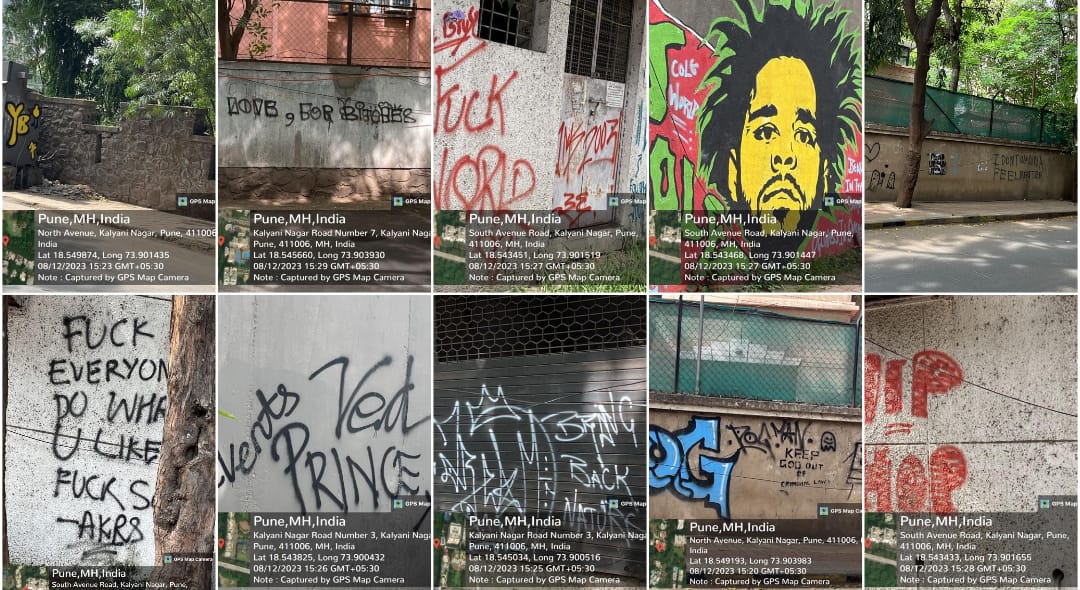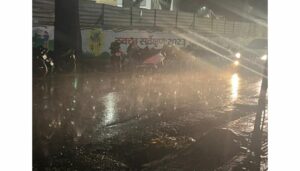Pune: Vandalism and Health Hazards Caused by Spray Paint on Society’s Outer Walls in Kalyani Nagar

Kalyani Nagar, 13th August 2023: A wave of vandalism has swept through the serene streets of Kalyani Nagar, leaving several society’s outer walls defaced with offensive graffiti and images. The incident, carried out by mischievous individuals, has not only marred the aesthetic appeal of the neighborhood but has also raised grave health concerns among its residents.
Society complexes including Siddharth Estates, Waterfront, and Trump Towers have fallen victim to this act of vandalism, leaving residents both distressed and apprehensive about the implications of such reckless behavior.
The defacement, characterized by offensive words, meaningless quotes, and unwanted images, has sparked outrage within the community. Beyond the immediate visual impact, this act has unleashed a cascade of apprehensions regarding the psychological well-being of residents and the potential health hazards associated with the spray paint used.
Residents of the affected societies have voiced their deep concerns over the repercussions of this incident. The offensive graffiti not only tarnishes the appearance of the neighborhood but also inflicts emotional distress on those who encounter it regularly. Parents, in particular, are alarmed by the explicit content that their children are exposed to and the negative messages conveyed by the defacement.
One of the most concerning aspects is the health hazards linked to the spray paint. The fumes emitted by these paints contain volatile organic compounds (VOCs) and other harmful chemicals that pose threats to both human health and the environment. Prolonged exposure to these toxic fumes can result in respiratory problems, allergies, and various other health complications. This is particularly alarming for vulnerable individuals, such as children and those with pre-existing health conditions.
Key Health Concerns Include:
- Exposure to Toxic Chemicals: The inhalation of volatile organic compounds (VOCs) present in spray paint can lead to respiratory irritation, headaches, dizziness, and nausea.
- Respiratory Issues: The inhalation of spray paint fumes can exacerbate existing respiratory conditions like asthma and bronchitis, potentially causing chronic respiratory problems.
- Allergic Reactions: Some individuals may experience allergic reactions upon contact with the painted surface, leading to skin rashes, itching, and redness.
- Eye Irritation: The fumes and particles released during spray painting can cause eye irritation, redness, tearing, and discomfort. Direct contact with paint splatters may also lead to eye irritation and potential damage.
- Long-Term Health Effects: Prolonged exposure to VOCs found in spray paint has been linked to long-term health issues, including damage to the central nervous system, liver, and kidneys, as well as an increased risk of certain cancers.
- Environmental Impact: Spray paint contains chemicals that are harmful to the environment. Vandalism involving spray paint contributes to air and water pollution, affecting both human health and ecosystems.
- Community Distress: In addition to health hazards, the presence of graffiti and defaced walls can cause distress and anxiety within the community, impacting mental well-being, especially if the content is offensive.
- Children and Vulnerable Populations: Children and individuals with pre-existing health conditions are particularly vulnerable to the adverse health effects of spray paint exposure.
- Secondary Exposure: The fumes and particles from the spray paint can continue to be emitted even after the initial act of vandalism, putting anyone who interacts with the affected area at risk of exposure.
The repercussions of this act of vandalism extend beyond immediate health concerns. It has created an atmosphere of insecurity and distress among residents, sending a negative message about the community. Property values may be adversely affected, impacting homeowners’ investments. Furthermore, the collective financial burden of repairing the defaced walls falls squarely on the shoulders of the affected residents.
Recommended Actions for Authorities:
- Thorough Investigation: Law enforcement agencies must initiate a comprehensive investigation to identify the culprits responsible for this act of vandalism. Utilizing surveillance footage, eyewitness accounts, and available evidence will be crucial in bringing the culprits to justice.
- Legal Accountability: Once the individuals behind the vandalism are identified, legal actions and consequences should follow suit. Charges related to property damage and vandalism must be pursued rigorously to discourage future acts of this nature.
- Community Dialogue: Local authorities should initiate open discussions with the community to address the incident’s implications. Conducting town hall meetings or forums where residents can voice their concerns will foster a sense of unity and shared responsibility.
- Education and Prevention Programs: Implement educational programs in schools and community centers to raise awareness about the detrimental impacts of vandalism. Promote the significance of respecting public spaces, the environment, and the overall well-being of the community.
- Enhanced Surveillance: Strengthen surveillance systems by installing security cameras or upgrading existing ones in public areas to deter potential vandals and aid in the apprehension of wrongdoers.
- Regular Maintenance: Prioritize the consistent upkeep and cleanliness of public spaces to discourage the establishment of vandalism. Swift removal of graffiti and defacement serves as a deterrent against further acts.
- Community Policing: Empower community members to remain vigilant and report any suspicious activities, contributing to the prevention of vandalism. Initiating neighborhood watch programs can encourage a sense of shared ownership in safeguarding the community’s appearance and security.
- Youth Engagement: Channel the energies of local youth into constructive and creative endeavors, diverting their focus from destructive behavior. Organize art workshops and projects to provide a positive outlet for their creative expression.
- Restoration Initiatives: Collaborate with local artists or community members to restore the defaced walls, transforming a negative incident into a positive opportunity for community involvement and beautification.
- Public Awareness Campaigns: Launch comprehensive public awareness campaigns across local media outlets, social media platforms, and community events to educate residents about the adverse consequences of vandalism and the significance of preserving public spaces.
- Eco-Friendly Solutions: Promote the use of environmentally friendly and non-toxic methods for graffiti removal to minimize the environmental impact of cleaning up defaced surfaces.





